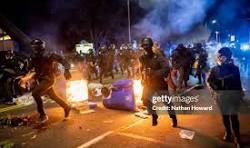Riots can have significant and multifaceted effects on real estate, impacting both residential and commercial properties. Here are some key effects:
1. Property Damage
Riots often involve vandalism, looting, and arson, leading to substantial damage to buildings and infrastructure. This damage can result in:
- High repair costs for property owners.
- Increased insurance premiums.
- Temporary or permanent closure of businesses.
2. Decreased Property Values
The perception of an area as unsafe or unstable can lead to a decline in property values. Factors contributing to this include:
- Reduced demand for housing and commercial spaces.
- Increased vacancy rates.
- Lower investor confidence.
3. Flight of Residents and Businesses
Fear and uncertainty can prompt residents and businesses to relocate to safer areas. This exodus can lead to:
- Decreased population density.
- Loss of economic activity and local jobs.
- Strain on municipal resources due to decreased tax revenues.
4. Insurance Issues
In areas prone to riots, obtaining property insurance can become more difficult and expensive. Insurers may:
- Increase premiums for coverage.
- Impose stricter terms and conditions.
- Refuse to insure properties in high-risk areas altogether.
5. Long-Term Economic Impact
Riots can have prolonged economic consequences for affected areas, such as:
- Slower economic recovery and development.
- Decreased investment in local businesses and infrastructure.
- Increased public spending on rebuilding and law enforcement.
6. Changes in Urban Development Patterns
Persistent unrest can alter urban development patterns, including:
- Shift of commercial activities to safer suburbs or other cities.
- Gentrification if the area is redeveloped with an influx of new investments.
- Decline in previously thriving commercial districts.
7. Impact on Local Government Finances
Reduced property values and business closures can lead to a decline in tax revenues, affecting local government finances and their ability to:
- Fund public services and infrastructure projects.
- Maintain law and order.
- Provide social services to residents.
8. Social and Psychological Impact
The social fabric of neighborhoods can be disrupted, leading to:
- Increased stress and anxiety among residents.
- Breakdown of community cohesion and trust.
- Negative perceptions of the area that persist long after the riots.
Mitigation and Recovery
Efforts to mitigate and recover from the impact of riots on real estate include:
- Rebuilding and renovation initiatives.
- Investment in community policing and public safety.
- Economic incentives for businesses to return and invest in affected areas.
- Programs to support displaced residents and promote social cohesion.
In summary, the effects of riots on real estate are far-reaching and can have lasting consequences on property values, community stability, and local economies. Addressing these impacts requires coordinated efforts from property owners, businesses, local governments, and community
Riots can have significant and multifaceted effects on real estate, impacting both residential and commercial properties. Here are some key effects:
1. Property Damage
Riots often involve vandalism, looting, and arson, leading to substantial damage to buildings and infrastructure. This damage can result in:
- High repair costs for property owners.
- Increased insurance premiums.
- Temporary or permanent closure of businesses.
2. Decreased Property Values
The perception of an area as unsafe or unstable can lead to a decline in property values. Factors contributing to this include:
- Reduced demand for housing and commercial spaces.
- Increased vacancy rates.
- Lower investor confidence.
3. Flight of Residents and Businesses
Fear and uncertainty can prompt residents and businesses to relocate to safer areas. This exodus can lead to:
- Decreased population density.
- Loss of economic activity and local jobs.
- Strain on municipal resources due to decreased tax revenues.
4. Insurance Issues
In areas prone to riots, obtaining property insurance can become more difficult and expensive. Insurers may:
- Increase premiums for coverage.
- Impose stricter terms and conditions.
- Refuse to insure properties in high-risk areas altogether.
5. Long-Term Economic Impact
Riots can have prolonged economic consequences for affected areas, such as:
- Slower economic recovery and development.
- Decreased investment in local businesses and infrastructure.
- Increased public spending on rebuilding and law enforcement.
6. Changes in Urban Development Patterns
Persistent unrest can alter urban development patterns, including:
- Shift of commercial activities to safer suburbs or other cities.
- Gentrification if the area is redeveloped with an influx of new investments.
- Decline in previously thriving commercial districts.
7. Impact on Local Government Finances
Reduced property values and business closures can lead to a decline in tax revenues, affecting local government finances and their ability to:
- Fund public services and infrastructure projects.
- Maintain law and order.
- Provide social services to residents.
8. Social and Psychological Impact
The social fabric of neighborhoods can be disrupted, leading to:
- Increased stress and anxiety among residents.
- Breakdown of community cohesion and trust.
- Negative perceptions of the area that persist long after the riots.
Mitigation and Recovery
Efforts to mitigate and recover from the impact of riots on real estate include:
- Rebuilding and renovation initiatives.
- Investment in community policing and public safety.
- Economic incentives for businesses to return and invest in affected areas.
- Programs to support displaced residents and promote social cohesion.
In summary, the effects of riots on real estate are far-reaching and can have lasting consequences on property values, community stability, and local economies. Addressing these impacts requires coordinated efforts from property owners, businesses, local governments, and community
